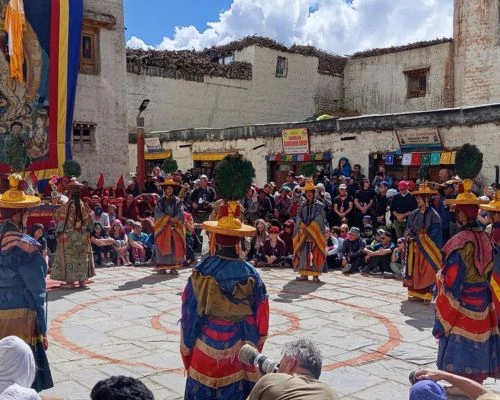Kanchenjunga Circuit Trek is one of the best-unsullied 19 Days trekking in Nepal. The journey presents awesome Himalayan vistas and the opportunity to walk through the subtropical lowlands of Nepal, adorned with striking glacial highlands, enthralling rhododendron woods, and beautiful villages.
The journey’s experience can be described only as blissful as you make your way through the traditional rural Nepal settings and confront the pristine massif of mountains.
Taking place right at the very border of Nepal, the Kanchenjunga Circuit Trek presents trekkers a chance to explore and experience the exotic Limbu, Rai, Magar and Tibetan Sherpa cultures of the Taplejung district.
Mount Kanchenjunga, the third highest mountain in the world and the second-highest mountain peak in Nepal, stands vigilantly over the ethnic Rai, Magar, Gurung, and Tibetan Sherpa settlements and villages of the region in a melancholic manner, covered in a snowy patina of ivory.
Due to the region's relative isolation, the Kanchenjunga Trek presents untouched natural environments and gleaming terrains that are unspoiled by the influx of visitors to the area. In like manner, it is the best less-trodden and less-tourist trekking trail in all of Nepal. You can also have a glimpse of the rare animals that reside within the Kanchenjunga Conservation Area, like the Musk Deer and the Blue Sheep.
Furthermore, the Kanchenjunga Circuit Trek is a gorgeous adventure that perfectly combines rural Nepalese Himalayan life with perfect natural settings. The Kanchenjunga trekking trails are decorated beautifully with chartreuse and emerald foliage, lush verdant trees, and pine-scented acreages. Because of the isolation of the trek, the journey presents an amazing natural quintessence with untouched green environments.
Join us for the best and most memorable Kanchenjunga Circuit trekking experience. Our professional staff and team members will make sure that the journey is well-serviced and that our customers are safe, comfortable, and satisfied at all times.
Come to join us in this ravishing adventure where you can experience the aesthetically pleasing magnificence of the mountains, alluring natural beauty, and have a closer look at the culture, lifestyle, and traditions of the ethnic Taplejung people of rural Nepal.
What to Expect from the Kanchenjunga Circuit Trek ?
The Kanchenjunga Circuit Trek is a challenging yet rewarding journey through Eastern Nepal’s remote regions. This trek offers incredible views of the world’s third-highest peak, Mount Kanchenjunga, along with other towering summits, rolling hills, and rich local cultures. Here’s what you can anticipate:
- Majestic Peaks: You’ll be surrounded by the awe-inspiring peaks of Kanchenjunga, Makalu, and other mountains, providing breathtaking vistas and a true sense of adventure.
- Cultural Insights: The trek traverses remote villages inhabited by diverse ethnic groups, offering a unique glimpse into local traditions and ways of life.
- Challenging Terrain: Expect steep ascents and descents, rugged trails, and high altitudes. The sense of accomplishment from completing this trek is unparalleled.
- Diverse Wildlife: As you trek through dense forests, you may encounter wildlife like the Himalayan black bear, red panda, and musk deer.
- Peaceful Solitude: Unlike more popular treks in Nepal, the Kanchenjunga Trek is less crowded, allowing for a serene and peaceful experience.
- Adventure and Scenery: This trek combines stunning mountain scenery, cultural diversity, and a true sense of adventure, making it an unforgettable experience for trekkers of all levels.
Is the Kanchenjunga Circuit Trek suitable for you?
The Kanchenjunga Circuit Trek is demanding and requires good physical fitness and preparation. Before starting this trip, take into consideration the following:
- Physical Fitness: Long days of hiking at high altitudes with steep climbs and descents demand a high level of fitness and endurance.
- Altitude Sickness: The trek reaches altitudes up to 5,160 meters, posing a risk of altitude sickness. Proper acclimatization and awareness of symptoms are essential.
- Trekking Experience: This trek is not for beginners. Previous high-altitude trekking experience and comfort with rough trails and remote environments are necessary.
- Time Commitment: The trek is lengthy, requiring a minimum of two weeks. Ensure that you have sufficient time to do it.
- Cost Considerations: Due to its remote location and limited facilities, the trek can be costly. Make necessary adjustments to your budget for unforeseen costs.
If you are an experienced trekker with good physical fitness and a spirit of adventure, the Kanchenjunga Circuit Trek is perfect for you. However, if rough trails, remote settings, or high altitudes are not to your liking, consider other trekking options.
Kanchenjunga Circuit Trek Cost for 2025 and 2026
The cost for the Kanchenjunga Circuit Trek ranges from USD 2,599 to USD 3,599 per person, varying based on group size and facilities. Daily expenses for the trek are influenced by your travel style and plans.
Himalayan Recreation offers the Kanchenjunga Circuit Trek cost based on group size. Here are the details:
No. of Pax | Starting price (USD) |
2 Pax | 3099 USD Per person |
3 to 5 | 2599 USD Per person |
6 to 8 | 2299 USD Per person |
9 to 12 | 2099 USD Per person |
Note: Please feel free to Email us or WhatsApp if you have any questions or would like further information


 3 reviews
3 reviews
